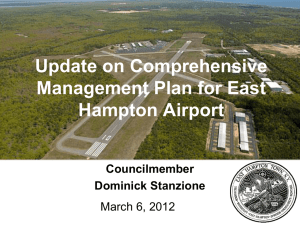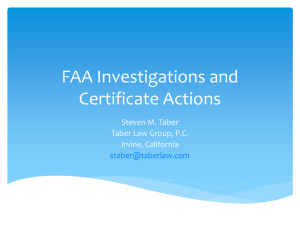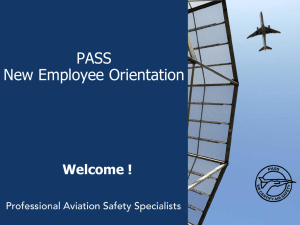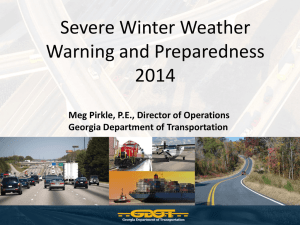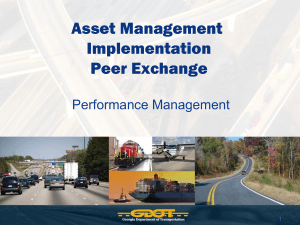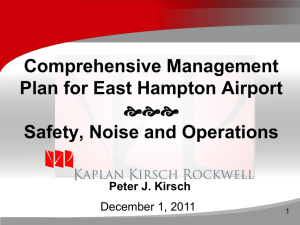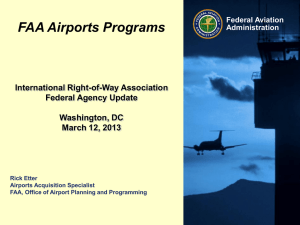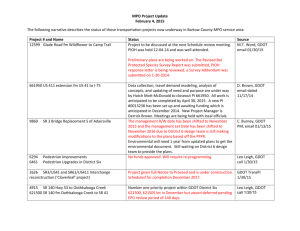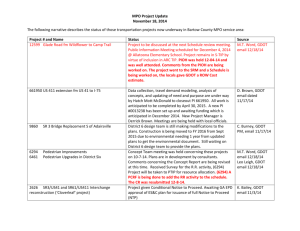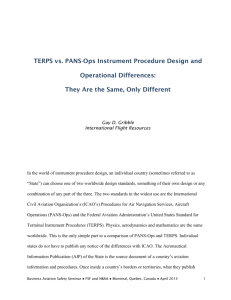Airport Obstruction Issues - Georgia Airports Association
advertisement
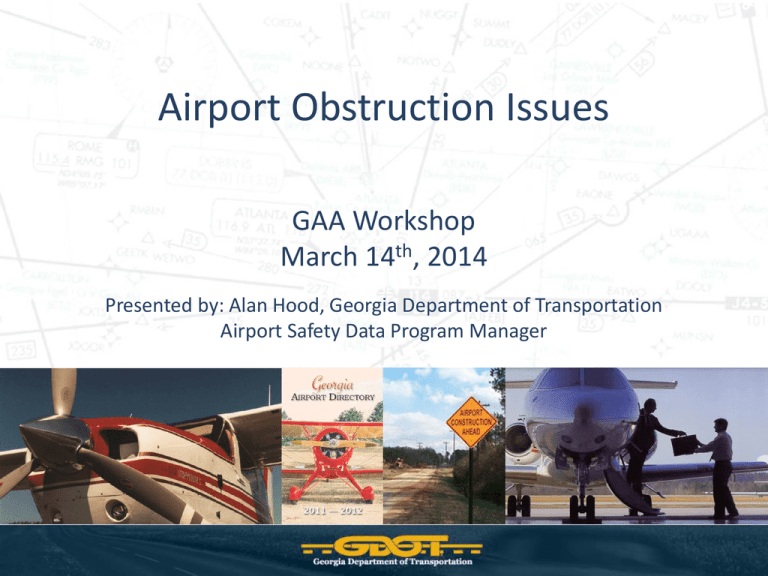
Airport Obstruction Issues GAA Workshop March 14th, 2014 Presented by: Alan Hood, Georgia Department of Transportation Airport Safety Data Program Manager Approach Surfaces and Obstruction Removal • 3 categories of approach surfaces for GA Airports. – State Licensing – Part 77 – TERPs Visual Surface (20:1) New GDOT Airport Licensing Approach Standards • New State Licensing – 3 configurations - based on runway length • < 4,000’ • 4,000’ – 4,999’ • 5,000’ + – Meets visual approach criteria from design guide • Surface starts at threshold • Surface should be clear to meet the minimum state licensing criteria • Generally least restrictive of the three surfaces • Airports inspected biennially New GDOT Airport Licensing Approach Standards 20:1 20:1 15:1 700’ To 10,300’ To 5000’ To 3000’ 1000’ 1800’ 2250’ 300’ 14 <4000’ 400’ 14 32 250’ 14 120’ 500’ 32 32 4000’ – 4999’ >5000’ New GDOT Airport Licensing Approach Standards • Obstruction Removal – obstructions should be removed immediately or removal efforts should be initiated as soon as possible with written plan provided to GDOT by specified date in letter. – if removal is not possible, displace threshold • Documentation of obstructions: biennial inspection letter • Notification – Alan Hood, Airport Safety Data Program Manager and – GDOT Project Manager Part 77 Approach Standards • Generally most restrictive, used as screening criteria • 6 configurations: Based on runway category and type of approach <12,500lb + visual = A(V) <12,500lb + non-precision = A(NP) >12,500lb + visual = B(V) >12,500lb + non-precision @ > ¾ mi visibility = C >12,500lb + non-precision @ < ¾ mi visibility = D >12,500lb + precision = PIR • Surface starts 200’ from threshold • Surface should be clear to meet FAA 5010 Safety Data Inspection Program criteria • Airports inspected biennially Part 77 Approach Standards 40,000’ 50:1 10,000’ 34:1 34:1 5,000’ 20:1 20:1 20:1 250’ 500’ 500’ 500’ 1000’ 1000’ 14 14 14 B(V) 14 A(V) 14 32 14 32 32 32 32 32 A(NP) C D PIR Part 77 Approach Standards • Obstruction Removal – Obstructions should be removed or provide schedule for removal • Documentation of obstructions: • biennial inspection letter • FAA 5010 report • Notification Required – Provide sketch and coordinates of cleared area – Alan Hood, Airport Safety Data Program Manager and – GDOT Project Manager – GDOT will coordinate with FAA to remove from FAA database FAA Straight-In TERPs Visual Surface Standards (20:1) • Surface starts 200’ from threshold • 20:1 Approach Slope • Obstructions should be mitigated to maintain night minimums • When are procedures reviewed? – Any request for change in approach, name change, LOC-ID change, runway numeral change, etc – FAA performs review of airport’s terminal procedures every 2 years FAA Straight-In TERPs Visual Surface Standards (20:1) 20:1 20:1 500’ Part 77 surface is larger than TERPs except in A(NP) and C Category Runways with at least a Category C published approach 34:1 20:1 500’ 800’ 800’ 14 14 32 32 A(NP) C Exists at 56 Airports in GA FAA Straight-In TERPs Visual Surface Standards (20:1) • Obstruction Removal – mitigate obstructions by: • removal • lighting • PAPI waiver – requires FAA Flight Standards approval – obstructions should be mitigated to maintain nighttime procedures and coordinated per new guidelines if given notice after Jan 6, 2014. • Obstruction removal previous to notice from Flight Procedures. – Sketch and coordinates of cleared area – Alan Hood, Airport Safety Data Program Manager and – GDOT Project Manager – GDOT notifies FAA to update database FAA Straight-In TERPs Visual Surface Standards (20:1) • If Notified by Flight Procedures of 20:1 Obstructions (After Jan 6, 2014): Who is Responsible? •Ultimately the Sponsor - State Licensing and Part 77 Inspections: When obstructions are identified in an inspection, they become a liability. - State Licensing surface obstructions could lead to denial of license. Who is Responsible? •Ultimately the Sponsor - Sponsors are also responsible for ensuring the TERPs Visual Surface is clear. Flight Procedures uses the FAA surveyed obstruction database to review procedures. - Obstructions do not automatically disappear from database with a new survey. - Must submit sketch with coordinates and boundaries of cleared areas to get obstructions removed from database. ***If you have been notified you have obstructions by Flight Procedures – then you validate the obstructions in writing. No survey or coordinates and boundaries required. Questions?
